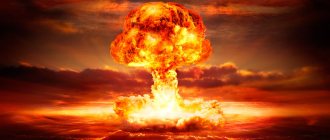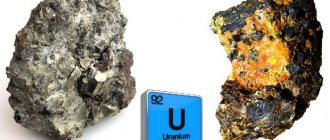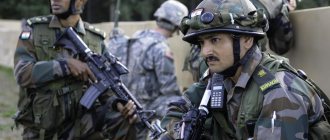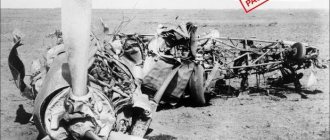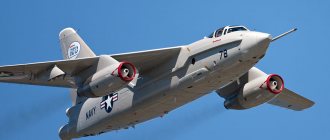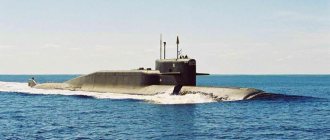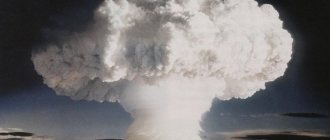Delhi sees atomic weapons only as a means of deterrence
The history of India's development after gaining independence in 1947 shows that with the increase in its economic capabilities, the military potential of the state also increased significantly. The emergence of the Indian economy at the end of the 20th and beginning of the 21st centuries at the global level increasingly raises the need to improve its defense capabilities, an integral part of which is the nuclear arsenal. At the same time, nuclear weapons (nuclear weapons) were considered and continue to be considered by the country's leadership not so much as a means of warfare, but as a forced political attribute in order to contain their neighbors - nuclear-armed China and Pakistan.
FORMATION OF THE NATIONAL PROGRAM
Indian scientific research in the field of nuclear science and technology began during the Second World War, and on April 6, 1948, the country's government, headed by J. Nehru, adopted the Atomic Energy Act. In accordance with it, the Atomic Energy Commission of India was formed, headed by H.D. Bhabha, who became the founder of the country's nuclear program. At the same time, J. Nehru in March 1949, answering questions in parliament, said: “We are not thinking about creating an atomic bomb.” On the other hand, he recognized that “if the need arises, there must always be an inherent advantage in defense capability,” meaning nuclear weapons.
These two different approaches set the tone for India's future military policy and its nuclear component.
In August 1954, the Indian Ministry of Atomic Energy was created, headed by H.D. Bhabha, a year later - the Atomic Energy Research Institute in Trombay, which later became the Atomic Energy Research Center (On January 12, 1967, Indira Gandhi renamed the Atomic Energy Research Center as the H.D. Bhabha Atomic Research Center, which died in a plane crash on January 24, 1966). In July–October 1955, Great Britain supplied India with 6 kg of enriched uranium, and with its help the construction of India's first research reactor, Apsara, began. In September of the same year, Canada agreed to supply India with a powerful 40-megawatt reactor, and the United States pledged to supply 18.9 tons of heavy water for it in February 1956, and thus the name of the Cirus reactor (Cirus: Canada–India Reactor) was born. –US).
The acquisition of the reactor was a turning point on the road to India's atomic bomb. It could produce enough plutonium for one or two bombs a year. Cirus became the prototype for the more powerful 100-megawatt Dhrava reactor for producing plutonium. According to various estimates, the Cyrus and Dhrava nuclear reactors allowed India to produce 25–35 kg of plutonium annually (“Cirus” was stopped in 2010, and “Dhrava” continues to “work” at the present time).
At the same time, the question of the possibilities of using nuclear energy for military purposes was not closed in the political and scientific circles of India. Remembering this, one of the authors of India's nuclear weapons program, Raja Ramann, Fr. However, the most powerful incentive to continue work on India's nuclear program was the first nuclear test in China in the fall of 1964. Due to this
Prime Minister L.B. Shastri said that “Chinese nuclear explosion is a threat to the whole world.” And Dr. H.D. Bhabha pompously said at a press conference in London in October 1964 that “Indian scientists can create an atomic bomb within 18 months.” Subsequently, Prime Minister I. Gandhi, in a letter to US President L. Johnson, stated that the neighbor’s nuclear policy was forcing India to carry out its tests. This was due to the fact that on May 9, 1966, the PRC conducted new nuclear tests, including the explosion of a thermonuclear device (the fifth in a row since 1964).
| Homi Bhabha (right) - President of the International Conference on the Peaceful Uses of Atomic Energy (Geneva, 1955). The photo also shows Ralph Bunche (center) and Ilya Chernyshev. |
| Source: Photo from IAEA Flickr page |
More than a year later, on October 6, 1967, Indian Defense Minister S. Singh, in his speech at a session of the UN General Assembly, stated that his country would not sign the Treaty on the Non-Proliferation of Nuclear Weapons (NPT), since it opposed the proliferation of nuclear weapons, but for the proliferation peaceful nuclear technologies. Therefore, India was not among the 62 states of the world, including three nuclear weapons - the USA, the USSR and the UK, that signed the NPT in 1968. In addition, two nuclear powers, China and France, as well as neighboring Pakistan, set a bad example for her at that time, who did not sign the NPT. India refused to sign this document as “not ensuring the security of non-nuclear states” (on June 12, 1968, the country’s parliament vetoed India’s signing of the NPT), although in fact it continued to engage in nuclear research. And on September 7, 1970, in a situation of tension with Pakistan, I. Gandhi gave permission to create and conduct an experiment with detonation of a nuclear explosive device (NED).
Preparations for testing the test nuclear explosive device were carried out in complete secrecy. Nobody in the world expected this. On May 18, 1974, India carried out the first test of the device - for “peaceful purposes”, as announced by I. Gandhi. The test is known as Operation Smiling Buddha. Coincidentally or not, the test coincided with the Buddhist festival day of Buddha Purnima, so perhaps this was the reason for the association with Buddha.
The 12 kt device, created on the basis of weapons-grade plutonium, was tested at a depth of 107 m. The explosion was carried out in a desert area near the abandoned village of Malka, 25 km northwest of Pokhran (Rajasthan) and in close proximity to the border with Pakistan.
After the first test, India pursued a unique policy of containment in the development of military nuclear technology. The reasons were both external and internal. Thus, immediately after the nuclear explosion, the United States imposed sanctions on India, gradually stopping the supply of nuclear fuel for the nuclear power plant in Tarapur. Canada launched a widespread campaign accusing India of using Canadian technology not for peaceful purposes, but to create a nuclear bomb. This forced India to slow down its nuclear weapons program. At that time, at the Atomic Research Center named after. H.D. Bhabha, the number of scientific and technical workers was already 10,532 people, but no one was laid off.
However, in early May 1979, India began to review its nuclear weapons policy in connection with receiving reports from various sources about Pakistan's policy towards the creation of nuclear weapons against the backdrop of strengthening Sino-Pakistani military cooperation, which led Islamabad to the possession of nuclear weapons in 1987. Moreover, some experts believed that these weapons were similar to the Chinese ones tested in 1964 and Pakistan did not need to conduct its own tests.
This affected the intensification of technological developments for the production of nuclear weapons in India, although the government did not make a decision to test it, only giving instructions on the creation of appropriate ammunition. Moreover, the development and testing of various types of missiles was carried out simultaneously. Among them: the short-range ballistic missile (BM) "Prithvi" ("Earth"), the medium-range ballistic missile "Agni" ("Fire"), as well as surface-to-air, "air-to-air" and others capable of carrying a nuclear warhead (YBZ). At the same time, Delhi repeatedly stated in the late 80s that the Prithvi were intended to use conventional warheads, and the Agni was intended only to “demonstrate India’s technological capabilities.”
Iran
Nuclear warheads - no information. Date of first test: no information. Date of last test: no information available. Today everyone knows which states have nuclear capabilities. And according to official reports, Iran has nothing to do with nuclear weapons. But this country has never stopped experimenting with developing nuclear capabilities, and there are persistent rumors that this power has its own nuclear warheads. Iranian authorities claim that they can easily create nuclear weapons for themselves, but for now they have decided not to do this because they use uranium only for scientific research. The IAEA monitors Iran's nuclear work; this agreement was concluded in 2015, but the situation may soon change. October 2022 - US President Donald Trump claims that the United States is no longer interested in this treaty. No one can predict how these words will change the overall political situation.
NUCLEAR PRIORITIES IN A CONDITION OF GLOBALIZATION
The international situation (the collapse of the USSR in 1991) and the military-political situation in the South Asian region began to change fundamentally since the early 1990s, which could not but affect the change in the Indian position on the nuclear issue. India, which took a firm position on the need to create a multipolar world in place of the previous bipolar system of the world order, proceeded from the fact that it might in the near future become one of the main players on the world stage along with the USA, China, Japan, and the European Union and Russia. In such a situation, India continued to develop its nuclear weapons program. This gave it the opportunity to test a bomb without a nuclear charge on May 18, 1994, adopt the Prithvi-1 missile into service, and then begin work on the Agni-1 missile. At the same time, India sought to acquire advanced nuclear technology, refusing in 1995, due to the expiration of the 25-year term of the NPT, which became indefinite, to re-sign and extend it. The Indian leadership reiterated its previous position that the document was “unequal, unfair and discriminatory.”
Taking into account the fact that on April 6, 1998, Pakistan tested the Ghauri-1 missile with a range of 1,100 km and a payload of up to 700 kg, capable of hitting various strategic targets on Indian territory, the country's leadership took a decisive step. In May 1998, India promptly carried out a series of five underground nuclear tests, called Shakti-98 (Shakti - “Power”). They were produced at the same Pokhran nuclear test site that tested a “peaceful explosive device” in 1974. After them, the country's Prime Minister A.B. Vajpayee said that “India is now a nuclear weapons state,” and one of the participants in these tests, A. Kalam, said: “We have destroyed the dominance of nuclear powers. Now no one can tell our nation of a billion people what to do. It's up to us to decide."
Taking into account the tense international situation, as well as the development of the nuclear programs of China and Pakistan, the Indian leadership in 2000 adopted a long-term defense budget plan (2001–2015), in which 20% (about $20 billion) was allocated for the development of nuclear forces, including including about 75% for the development of nuclear weapons and 25% for the management of nuclear forces. For this purpose, in January 2003, a special body was created, called the Nuclear Command Authority - NAC, which consisted of a Political Council, headed by the Prime Minister of the country, and an Executive Council. The latter provided the new structure with information and carried out the directives of the Political Council. To directly implement the instructions of the UYAC, the Strategic Forces Command (CSF) was created, which was responsible for managing them. At the same time, the Prime Minister was named as the only person with a “nuclear button.”
After bringing some clarity to its nuclear policy, the Indian leadership, in accordance with the long-term defense budget for 2001–2015, continued to create nuclear weapons and their delivery systems. As a result, India's nuclear arsenal increased quantitatively and improved qualitatively. So, if in 1998, after a series of tests, there were only 2 nuclear warheads, and in 2005 - 44, then in 2016 there were already 90–110 nuclear warheads (according to some sources, this figure can be increased to 150). Also, the Indian Armed Forces, until recently, had land (ballistic missiles of various ranges of the Agni and Prithvi families), air (Mirage-2000, Su-30MKI, MiG-27ML, Jaguar aircraft) and sea (the first SSBN of its own construction "Arihant", the second - "Aridhaman" - launched in 2016) by YaBZ delivery vehicles.
DPRK
Nuclear warheads – 10-60. Date of first test: 2006. Last test date: 2022. The DPRK was included in the list of states that have nuclear weapons in 2022, which greatly frightened the entire Western world. North Korea began its first work on the atom in the middle of the last century, when the United States began to threaten Pyongyang with a nuclear attack. And then the frightened government began to seek support from the Soviet Union and China. Developments in the nuclear field started back in 1970 and were suspended in the nineties, with an improvement in the political climate. And as soon as the political situation cracked again, the development of nuclear weapons was resumed. Since 2004, North Korea began preparing for its first nuclear test. The military department argued that the test would pass with only a harmless goal - space exploration. Intrigue surrounds the number of warheads that North Korea has in its arsenal. Some sources claim that there are about twenty of them, others claim that the exact figure is sixty.
Russia
Nuclear warheads - 7000. Date of first test: 1949. Date of last test: 1990. Russia received nuclear weapons from the USSR - all available nuclear warheads were collected from all military points of the former Soviet Union. According to official sources, the government of the Russian Federation, nuclear weapons will only be used in response to such military actions against their country. Or if Russia's very existence is threatened by military action without the use of nuclear warheads, it can still use them against the enemy, but this is the most extreme case.
Is military action possible between North Korea and the United States?
The end of the last century was marked by people's fear of military action between Pakistan and India, and now everyone is afraid of a possible nuclear conflict between the DPRK and the United States. The United States first threatened North Korea in 1953, but once North Korea had its own atomic bomb, the conflict moved to a completely different level. Pyongyang and Washington respond to each other very aggressively and the question becomes urgent: will there be a nuclear battle between the United States and North Korea? This may well be the case if President Trump believes that the Koreans are very dangerous because they can make an intercontinental missile that can sink all of America. Nuclear warheads have been located near the DPRK border since 1957, by order of the US government. Korean politicians say that almost the entire territory of America is within the reach of North Korea's nuclear warheads.
What position will Russia take in the conflict between North Korea and the United States?
The pact concluded between Russia and North Korea does not imply that Russia will take any side in the war. In general terms, this means that if hostilities begin, Russia can be neutral; naturally, it will only have to condemn the action of the attacking side. In the worst case scenario, Vladivostok could be covered in radioactive fallout from the destroyed North Korean facilities.
France
Warheads: 384
The five nuclear powers are those countries that are officially allowed to have these weapons. Their charges are mainly located on submarines and in aviation systems. The French began the program in the winter of 1954 and 6 years later they conducted their first test, and the last at the end of 1995. In total, 210 checks have been performed in their history. There were times when the state counted on the help of the Americans in this matter, but then they decided to independently engage in the development of nuclear energy. At that time, Russia was already the best nuclear power, and the French were only striving for this.
Great Britain
Nuclear warheads - 215. Date of first test: 1952. Date of last test: 1991. The UK remains the only nuclear-armed country that has not conducted a nuclear test on its own soil. Britain carried out each nuclear test in Australia or in the waters of the Pacific Ocean, but in 1991 they suddenly stopped their experiments. David Cameron in 2015 “added fuel to the fire” by saying that the British government could, if necessary, drop several nuclear warheads. But who he threatened still remains a mystery.
USA
Nuclear warheads - 6800. Date of first test: 1945. Date of last test: 1992. The state with the most fearsome army on the planet is also a pioneer in nuclear testing. The United States was the first to carry out a nuclear explosion, and was also the first to use nuclear warheads in a war with another state. Since that time, the United States has produced more than 66,500 atomic weapons, with more than a hundred different variations. The basis of the nuclear weapons of the United States is the ballistic missile, with a variety of modifications. The American government refused to participate in the negotiations on the unconditional renunciation of nuclear weapons that started in May of this year (by the way, like the Russian Federation). The military doctrine of the United States confirms that Americans will reserve the right to a certain amount of weapons that will guarantee their own security, as well as the security of countries friendly to them. In addition, America promised not to bomb non-nuclear countries, unless, of course, they comply with the terms of the Non-Proliferation Treaty.

